Editor’s Note: CR80News asked several industry veterans to comment on the recent acquisition of Diebld’s Card System Division by The CBORD Group. Bob Huber is a leading consultant in the area of campus card systems. His observations on what the transaction may mean to the campus card market follow.
By Robert C. Huber, Business Consultant
I believe this is overall very positive for the entire campus card industry. CBORD has set the “customer satisfaction” standard for the industry for over 20 years and proven their ability to grow to be the largest card system company without loosing sight of their customers.
CBORD has taken over several other companies in their past and been quite strategic in blending new employees and customers into their existing “corporate family” in a positive manner.
Combining the strengths and competencies of both organizations should provide you synergy and will probably signal a new round of buying and selling of campus card companies – and provide more competition and better service industry-wide in the long-term.
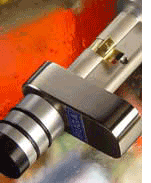 Imagine replacing only the cylinder inside your existing door mechanical door locks and converting them into electronic access control devices. That is the concept behind products from BUGA, a German company, that is turning traditional key-based locks into prox and contactless readers that integrate into wider access and security systems.
Imagine replacing only the cylinder inside your existing door mechanical door locks and converting them into electronic access control devices. That is the concept behind products from BUGA, a German company, that is turning traditional key-based locks into prox and contactless readers that integrate into wider access and security systems.
BUGA’s flexible, cost-effective electronic cylinders enable to easily add electronic functionality to mechanical locks
Major ASSA ABLOY divisions are already tapping BUGA´s know-how to expand their product portfolio and increase their business
BUGA Technologies GmbH, a leading OEM supplier of smart RFID cylinders for locks, has developed a simple, easily adaptable and cost-effective
electronic cylinder that can be used to add RFID functionalities to mechanical locks. The “e-cylinder” will significantly impact the access control market, allowing to implement electronic functionalities in doors where it was previously not cost-effective or impossible to do so.
Since the development of card-based electronic access control, there has been incompatibility between the concept of doors that are secured by a traditional, mechanical cylinder lock and doors that are secured with electronic access control readers: one requires a physical key while the other needs a credential containing an RFID (radio frequency identification) transponder. Buildings with both types of access control systems require a double management system - one for the cards and one for the keys – a solution which is inconvenient and inefficient.
BUGA’s product, the BINoXX - DK 4100 Smart RFID Electronic Cylinder, is
designed to address this problem. It can replace a mechanical cylinder, allowing existing contactless RFID-based access control credentials to open doors which previously required a key. They are ideally suited to complete the portfolio of OEMs wishing to expand into the growing market of electronic access control systems, such as time & attendance, access control suppliers or cylinder manufacturers.
By integrating BUGA’s ready-to-use electronic cylinders into their
mechanical lock portfolio, ASSA ABLOY and other OEM lock companies will be able to offer complete high-performance building access control solutions that work with a single electronic credential. ASSA ABLOY France and ASSA ABLOY Germany are presently working with BUGA to integrate the technology into their product portfolio.
The battery-powered cylinder recognizes all major transponder types,
including Hitag, MIFARE, HID Prox, etc. Each cylinder can be programmed to allow entry to authorized parties on the basis of pre-set times and dates. For example, if an employee is on vacation, the cylinder can be programmed not to open if the carrier tries to enter during his/her scheduled days away from the office. The BINoXX – DK 4100 is also designed with a double-knob feature that makes it possible to exit a door without the need to present a valid credential.
About BUGA Technologies GmbH
BUGA is a leading OEM supplier of smart RFID cylinders, specialized in
integrating electronic intelligence into mechanical locks using RFID
technology. Founded in 1988 as experts in mechanical master key systems, cylinders, locks and accessories, BUGA developed the concept of electro-mechanical locks in the late 1990s. In 2000, aiming to combine the advantages of electronic access control with the security of mechanical door cylinders, BUGA presented its first Electronic Cylinder in a Key/Knob version. Since then, BUGA has added many more features to its product portfolio, whose security features and ease-of-use are unique. BUGA is headquartered in Norderstedt, Germany (www.buga.de).
In a move that is certain to have lasting impacts on the campus card landscape, CBORD announced the acquisition of the Card Systems Division from Diebold today. CR80News editorial team will be interviewing key players throughout the day and will update readers with breaking info and insight as the day progresses. The press release follows …
CBORD Announces Acquisition of Diebold Card Systems Division
Deal makes CBORD dominant provider of cashless systems
Ithaca , New York– The CBORD Group, Inc., one of the world’s leading suppliers of campus card, housing, and foodservice management systems for the College & University market today announced that it has acquired Diebold Card Systems Division (DCSD). DCSD is the business unit of Diebold, Incorporated (NYSE: DBD) dedicated to campus card and housing management systems for colleges and universities. The acquisition makes CBORD the dominant provider of cashless systems to the College & University, Business & Industry and Healthcare markets, with more than 750 installed cashless systems and over 100 campus housing systems under current management.
Bruce Lane, Executive Vice President of CBORD, said, “The combined talent and resources of our organizations will enable CBORD to provide greater value to customers through exceptional service and the economies and expertise of a larger organization. More than six million cardholders will have access to a wider range of products, and exciting new Web-based products that take advantage of our shared technology.”
Brad Stephenson, Vice President, Physical Security Group at Diebold, added, “Diebold Card Systems Division and CBORD each have a long history of providing quality administrative products to their customers. By integrating the two organizations, we will be able to offer the unique products of both companies in a smooth and seamless customer experience.”
CBORD has plans in place to expand in its current markets as well as emerging markets such as continuing care retirement centers, private secondary schools and sport complexes. CBORD’s product suite now includes: Odyssey PCS Cashless System, CS Gold Campus Card System, housing management systems, judicial management systems, access control systems, cashless vending, point of sale and self-order kiosk solutions, food and nutrition management systems, e-commerce and the Webfood On-line Ordering solutions.
The combined operation will be headquartered in Ithaca, New York and have offices in Farmington, New York; Green, Ohio; Waco, Texas; and Cypress, California.
About The CBORD Group, Inc.
The CBORD Group, Inc., founded in 1975, is currently marking thirty years of service to the campus-wide needs of higher-education facilities. CBORD works with a wide variety of clients and markets, providing cashless and ID card privilege control systems, housing management systems, and Webfood online ordering service. In addition, CBORD serves thousands of chain restaurants, hospitals, universities, supermarkets, and gaming facilities with its suite of foodservice, catering, and nutrition software products. The CBORD Group has customers in the U.S., Canada, Europe, the Middle East, and Australia. To learn more about CBORD, visit us at www.cbord.com.
About Diebold Card Systems Division
The Card Systems Division of Diebold , Inc., has roots in campus ID cards dating back to 1964. This Card Systems division introduced the first computerized card system and led the industry through numerous generations of system development. Today Diebold Card Systems is a leading provider of campus ID card systems, access control systems, housing management systems, and CCTV.
by Danny Smith, ColorID (www.colorid.com)
One of the biggest differences between printing on blank PVC (Mag Stripe) card stock and proximity cards is the cost difference of the cards. Blank card stock may cost less than a dollar per card while Proximity cards average $3 - $8 (depending on options). Mistakes in the printing of Proximity cards can create significant financial losses. In order to protect your investment here are a couple important points you may consider.
Using Proper Proximity Printing Technology
Problem: Most blank card stock is constructed with an even flat surface, however Proximity cards contain an antenna and chip inside each card. Dye sublimation printers are direct to card printers. The deviation in the Proximity cards surface (from its internal contents) causes the printhead to lose contact with the cards surface. The result may be a loss of printed information. Some ID offices have accepted the end result with direct-to-card printing. However, improved technology is now available to dramatically improve the quality of your Proximity cards.
Solution: Fargo offers an HDP (High Definition Printer) series ID printer specifically designed for printing on Proximity and Smart Cards. The HDP’s printhead never touches the cards surface like a dye sublimation printer. The HDP prints onto a ‘transfer film’ first and is then transferred to the cards surface and adhered by pressure and heat. If the cards surface is uneven, the film will cover all its deviations. In addition, the print quality is amazing when compared to a dye sublimation printer. Since the printer film is not being fused into the card, its colors are more vibrant, clear and to the edge of each card. In addition, you can help protect your Proximity cards by adding the standard clear or holographic overlaminate to your cards surface. This will minimize fading and seal the card from the elements. The printer cost is only slightly higher than some dye-sublimation printers. The decreased number of misprinted cards and better print quality will help pay for itself in the long run. For those needing a better print quality with vibrant colors, we would suggest a High Definition Printer.
Extended Card Life – How to Protect Your Investment
Problem: Proximity cards that are not properly protected may last only 12 – 18 months before experiencing issues such as cracking, loss or fading of variably printed information, etc.
Solutions:
1.) Pre-Printing Proximity Cards – We recommend you lithographically Pre-Print Proximity cards. This will give you a much higher print resolution and more durable card. Overlay (1.5 mil) is used during the Pre-Printing process to protect the static information.
2.) Lamination – Using a lamination (1mil) overlay on your card to protect the variable information (image and data files), coupled with the Pre-Printed solution gives you the optimal protection.
Summary: Yes, it may initially increase your per card production cost by using the above methods. However, in the long run spending a little more in the beginning will ensure you are issuing cards that are properly printed and protected. Following the above recommendations should enable your cards to last 4-5 years under normal wear and tear.
 Printing high-quality color images on ID cards has become a straightforward, basic function for card program staff. This is a testament to the high quality printers, supplies, and plastic cards available today. But what happens when a new identification technology is added to the mix? Must our comfortable printing processes change if a proximity, contactless, or contact chip is added to the card?
Printing high-quality color images on ID cards has become a straightforward, basic function for card program staff. This is a testament to the high quality printers, supplies, and plastic cards available today. But what happens when a new identification technology is added to the mix? Must our comfortable printing processes change if a proximity, contactless, or contact chip is added to the card?
When an additional technology is embedded into a card, it is more difficult for the manufacturer to maintain a perfectly smooth surface on the plastic. Slight divots and protrusions tend to occur around the embedded objects (e.g. beneath the chip, above and below the antenna). Though often invisible to the human eye on the blank card, these imperfections can result in very visible problems with the image once the card is printed.
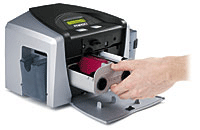 Different printers and processes provide different options
Different printers and processes provide different options
• Dye sublimation printing
Most ID cards that are printed onsite by the issuer use a printing process called dye sublimation. In this process, dye is transferred from a ribbon to the surface of the card via heat supplied by a component in the printer called the print head. When the print head encounters a divot or imperfection in the plastic surface, dye is not transferred to the plastic or is transferred incorrectly. This results in less-than-perfect image reproduction. It can also result in damage to the sensitive, and costly, print head.
According to Danny Smith, Executive Vice President, ColorID, “some ID offices have accepted the end result with direct-to-card (dye sub) printing. However, improved technology is now available to dramatically improve the quality of your Proximity cards.” It just depends on what quality and fall-out you are comfortable with.
• Re-transfer printing
An alternate printing process involves the transfer of the dye to a clear sheet of film that is then adhered to the plastic card such that the print head never touches the card itself. This method eliminates the image reproduction problems caused by surface imperfections. Explains Joe Wright, Director of Marketing, Fargo Electronics, “think of the film as a blanket that is laid across a bed. (The film) conforms to the bumps and imperfections on the card just like the blanket does on the mattress … the result is a smooth surface.”
According to Mr. Wright, the re-transfer process (what Fargo calls High Definition Printing or HDP), has three major benefits when printing on cards with embedded technologies. “It is improves the card’s image quality, it reduces the amount of fallout (wasted cards), and it reduces the potential damage to the printing system (that can occur with a dye sub print head on an imperfect card surface).”
This type of printer, says Mr. Wright, “costs about 40% more than comparable dye sub printers. Consumables cost about 20% more.” It is easy to see how this technology could quickly pay for itself through the reduction in wasted cards. Remember that prox, contactless, and chip cards are more costly than basic magnetic stripe cards, so each instance of fallout from an unacceptable quality print job adds up rapidly. Mr. Smith concurs, stating that “the decreased number of misprinted cards and better print quality will help pay for itself in the long run.”
• Ink jet printing
There is a third option for printing that can result in good quality images for technology-embedded cards. Inkjet printers for cards are available and they can be an acceptable solution for entry-level, low volume environments.
When preprinting makes sense …
Dennis Caulley, VP of Access ID, concurs that re-transfer printing is a good option for embedded technology printing but he stresses preprinting as well. “In many cases, the capital outlay for a new printer does not make sense for a client. By preprinting the majority of the card, you get a uniform consistent image on all cards.”
When the static images on a card (e.g. backgound graphics, reverse side text) are preprinted, only the small areas of personalized detail (e.g. photo, name, account number) are left to the onsite dye sub printer.
Can thicker cards help the printing process?
Though we are all conditioned to think “standards, standards, standards,” Mr. Caulley suggests that a slightly thicker card can alleviate some of the printing problems that arise when embedding technologies. Normal ISO standard cards are 30 mil in thickness. According to Mr. Caulley, this relatively thin number was set because of the need to emboss cards for financial purposes. 30 mil was a reasonable amount that embossers could handle.
“Moving to a 35 or 36 mil card,” he states, “is certainly helpful in terms of both printability and durability.” It seems that added mils help to even out the bumps and divots that occur when technologies are embedded between the layers of plastic. “It is all a surface profile issue,” he concludes.
How to proceed?
The most prudent path seems to involve a series of steps. First, investigate the different options available from your card manufacturer or other manufacturers. Next, consider purchasing a re-transfer style card printer evaluating not just the upfront costs but the amount it may save in the future. Evalutate preprinting costs and determine if this is a more cost-effective option for your program.
Finally, find a way to print some sample cards using the exact card types and printer types you are considering. You can do this in house your existing equipment and a small quantity of sample cards. You can also request your printer supplier to test a quantity of cards for your. Fargo, as well as other suppliers, offer this service free of charge.
Remember, thousands of card issuers around the world print on technology-embedded cards everyday. With a bit of research and planning, you will be able to attain high quality results for your program. A more advanced card does not need to compromise your image quality.
Additional resources:
ColorID developed a great write-up for CR80 focusing on challenges and solutions for printing on proximity cards. To read this article, click here.
Perhaps the most important feature of any credit or debit card is the 16-digit number unique to that card. It is called an ISO number, and it is the key for linking each transaction conducted with the card to the account and account holder responsible for the transaction. In the early 1990’s, these numbers began appearing on student ID cards, replacing earlier numbering schemes like Social Security Numbers or a series of randomly generated digits. But what makes these 16 digits so important? Why would an institution choose this numbering scheme over another? And how does one go about getting an ISO number? Read on.
The International Organization for Standardization (ISO) is a global federation of standards bodies that works to create standards on nearly every imaginable topic. Its subcommittee on Information processing systems, called Technical Committee 97 (TC 97), issued its specification ISO 7812 in the mid-1980’s. ISO 7812—titled Identification cards: Numbering system and registration procedure for issuer identifiers—prescribed the format for a standardized card numbering scheme.
The importance of the standard is that it was a precursor to any attempt to build an infrastructure of card reading devices capable of accepting meaningful data from cards provided by multiple issuers. The infrastructure was necessary for mass, cost-effective development of point of sale (POS) and ATM networks. In reality, this number was required for transaction routing and control while a standard placement of the number on the magnetic stripe was needed to ensure that card readers knew where to look for the ISO number on the card. This latter goal was accomplished by the American Bankers Association (ABA) magnetic stripe encoding standard.
 The first digit in an ISO number is called the Major Industry Identifier (MII). This number indicates the category best describing the card issuer owning the ISO number. The MII is broken down as follows: 1 = airlines, 3 = travel and entertainment, 4 = banking/financial, 5 = banking/financial, 6 = merchandizing and banking, 7 = petroleum. With limited exceptions, the Issuer Identifier encompasses the single digit MII and the five digits following it—for a total of six digits. In general, each card generated by an issuer starts with the same six digits.
The first digit in an ISO number is called the Major Industry Identifier (MII). This number indicates the category best describing the card issuer owning the ISO number. The MII is broken down as follows: 1 = airlines, 3 = travel and entertainment, 4 = banking/financial, 5 = banking/financial, 6 = merchandizing and banking, 7 = petroleum. With limited exceptions, the Issuer Identifier encompasses the single digit MII and the five digits following it—for a total of six digits. In general, each card generated by an issuer starts with the same six digits.
Giant card issuers such as the major financial institutions and credit card issuers will often have multiple Issuer Identifiers as they run out of unique numbers in one and must utilize others. The next nine digits form the Individual Account Identifier. In the same way that the first six digits name the card issuer, the next nine digits name the cardholder. Actually, the issuer can choose to use between nine and 12 digits for this section, resulting in an ISO number that is between 16 and 19 digits. The generation of these numbers is left up to the issuer. A skip factor or pattern is used to avoid issuing sequential numbers and thus making it overly simple for a person to guess at other valid card numbers by looking at one actual card number.
The final digit (number 16 unless the issuer has elected to use more than nine digits for the Individual Account Identifier) is a check digit, calculated by applying a simple mathematical formula to the preceding digits. This check allows a card reader to perform the calculation based on the first 15 digits it read from the magnetic stripe and check it against the final digit read. If they match, it is likely a valid read. If they do not compute, then the reader knows that the read was bad and requests that the card be swiped again.
Many campus card programs are utilizing the ISO numbering scheme. The main reason for this is its requirement if the card is to be used in the established financial networks.
If you plan to enable financial functionality within the banking networks, ISO numbering is a must. While many campus card systems utilize numbering scheme other than ISO numbers, all card readers and all manufacturers of meal plans, security systems, and other peripheral campus card elements can utilize the ISO number as the identifier. Those that tell you they cannot accomplish this should be asked to explain.
If you never plan to use add financial capabilities to your card program, this standardization may not be necessary. However, there seems to be little reason not to go to ISO numbering for new programs and/or new campus-wide re-issuances.
You do not have to be a bank to get an ISO number. Many schools that utilize the scheme own their own numbers while others have looked to their banking partner to obtain this number on their behalf.
In the past, many believed that the campus had to own their number so that it could be ported from one bank to another if contracts were moved. In reality, most universities that have switched banking partners have been forced to recard and utilize a new ISO number, making the ownership issue less significant.
Many financial institutions are unable to utilize an ISO number that is not their own as their internal systems are geared to accept only these numbers. If you have a banking partner, or are in the review process, ask for information. The application process to obtain a number is simple and costs only $600.
The process takes four to six weeks. In the U.S., applications are processed by ISO’s member body—the American National Standards Institute (ANSI). Application materials can be requested from ANSI by calling 212/ 642-4992 or visiting the on the web at ansi.org.
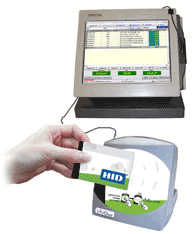 Gallaudet University, a 140–plus year-old Washington, D.C. school for the deaf and hard of hearing, wanted to add cashless payment capabilities to its existing HID proximity cards that controlled dorm access for students. The college didn’t want to replace its point of sale (POS) infrastructure, but the existing cash registers accepted only magnetic stripe cards. Enter ViVOtech with a reader that could enable the college’s existing system to think it was receiving data from a mag stripe card.
Gallaudet University, a 140–plus year-old Washington, D.C. school for the deaf and hard of hearing, wanted to add cashless payment capabilities to its existing HID proximity cards that controlled dorm access for students. The college didn’t want to replace its point of sale (POS) infrastructure, but the existing cash registers accepted only magnetic stripe cards. Enter ViVOtech with a reader that could enable the college’s existing system to think it was receiving data from a mag stripe card.
Gallaudet had already installed an HID prox card system to control building access, but students wanted the ability to use those same cards in place of cash. At the close of 2003, nine ViVOpay 3000 readers were installed, providing students with a cashless, contactless alternative when they visit the cafeteria or bookstore.
“It’s working out great,” said Mohammad Khan, ViVOtech’s president and COO. “There are two big values we offer in this installation. One is the same prox card can be used for access and payment. As a student you’re dealing with one device, which is very convenient. Second, they (Gallaudet) didn’t want a huge amount of changes. Our solution works with the existing POS system.”
 ViVOtech provided the plug-and-play technology that enables the college’s POS system to accept transactions from HID cards, he explained. The 3000 reader attaches to the magnetic stripe reader slot. “Through that attachment, it produces a signal that makes the (POS device) think it is being swiped,” explained Mr. Khan.
ViVOtech provided the plug-and-play technology that enables the college’s POS system to accept transactions from HID cards, he explained. The 3000 reader attaches to the magnetic stripe reader slot. “Through that attachment, it produces a signal that makes the (POS device) think it is being swiped,” explained Mr. Khan.
“From a consumer point of view,” he said, “you can hold the card, wave the card on the reader and you’re done with it. That provides speed and increased efficiency, especially during peak hours.”
Gary Aller, Gallaudet’s executive director, Business and Support Services, was extremely pleased with the project. “Using ViVOtech’s contactless readers and HID’s proximity cards have saved the University a tremendous amount of time and labor. We were able to use the University’s Simplex remote door opening system and a simple download of student names from that system to provide the database for our food service computer. The system was also easily expanded to include faculty and staff at a later date. I have been very pleased with the efficiency and reliability.”
“Our business is enabling contactless payment whether it be in a university, a corporation, or a retailer,” he added. The California-based company has shipped more than 75,000 readers in just the last 12 months, mainly in the U.S. to handle contactless cards produced by MasterCard, American Express and Visa.
“The value that our solution provides is that it takes the least amount of effort in software development costs,” adds Mr. Khan. “We are able to provide a very simple plug-and-play offering. Overnight, you could start accepting HID cards (for payment).”
It takes about less than half an hour to enable one POS system and requires no technical expertise. “Our guys spent a half day there,” said Mr. Khan in reference to the Gallaudet install. “It’s a good example of how different universities, using mag stripe cards, can turn into a contactless card system with a very small investment. It can issue a contactless card or fob to students.”
About Gallaudet University
Gallaudet University was founded in 1864 (its charter was signed by President Lincoln) and is the world’s only university offering educational programs to deaf and hard of hearing students at all learning levels. The university’s mission is to serve as a comprehensive, multipurpose institution of higher education for the deaf and hard of hearing. In addition to its undergraduate and graduate academic programs, the University also offers national demonstration elementary and secondary education programs.
 How secure is your ID card system? Fargo Electronics wants to help you find out. They have developed a series of self-assessment questions that will help card managers determine the gaps in their ‘supposedly’ secure ID cards. This non-proprietary interactive website tool was launched in April.
How secure is your ID card system? Fargo Electronics wants to help you find out. They have developed a series of self-assessment questions that will help card managers determine the gaps in their ‘supposedly’ secure ID cards. This non-proprietary interactive website tool was launched in April.
“We felt there was an awareness that needed to be driven home,” said Joe Wright, Fargo’s marketing director. “We wanted to make end users realize their vulnerabilities.”
A couple years ago, Fargo discovered that “a lot of customers didn’t realize the lack of security with their card system, card issuance process and the card itself. We wanted to develop a tool that would help users realize the level of security, or more importantly the risk, associated with their card program,” he added.
The page, available at http://www.fargo.com/assessment/select.asp, covers three vertical markets – corporate, education, and government. “The majority of our business falls in these three areas,” he said. Users also have to identify the area of the world they’re from, such as the U.S., Canada, Latin America, Europe, Middle East, Africa, or Asia Pacific.
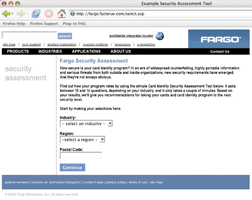 After choosing the area and region, and inserting a zip code, users then are asked to respond to between 10 (education) to 14 (government) questions.
After choosing the area and region, and inserting a zip code, users then are asked to respond to between 10 (education) to 14 (government) questions.
A common question among all three is the current state of the organization’s security system, i.e. what are they now doing to prevent forgery or preventing the card from being used by unauthorized personnel.
“It’s unfair to think that 14 questions online on the Internet will solve their security problems,” said Mr. Wright. “Our goal is to make people aware of security issues by asking questions to provide direction, and then give them an estimate of their level of risk.”
The Fargo self-assessment site won’t initially capture any contact information. “We try to remain neutral,” said Mr. Wright. Users can print off a recommendation report on the state of their card’s security which allows them to take this to their security director.” Fargo can also supply a page of recommended solutions, and it is there that a user can request help from a Fargo solution provider, added Mr. Wright.
A demo of the page was unveiled at the recent ISC West security conference. “We got some pretty positive response,” said Mr. Wright. “Many didn’t even realize their ID card system could be at risk. And, manufacturers of access control systems thought this would be a good tool; both for end users and as an awareness tool for sales and marketing.”
The self-assessment wasn’t ready for the NACCU conference, but Mr. Wright said Fargo will definitely demo it at next year’s show.
Mr. Wright believes that there are “two areas for security improvement in colleges; first, investing in a visual security element on the card, either a high secure custom hologram or secure foil card like Verimark or Holomark. College kids are getting pretty savvy with fake IDs.”
Second, he added, “A lot of people forget about their vulnerabilities within the card issuance process and system itself. Students make cards for other students. Staff uses the system for other purposes. There are solutions available to lessen the likelihood of this occurring, such as a lockable hopper or smart card controlled access (for system users and administrators). There are also software-driven solutions where you can control the hours of operation of the system, set-up notifications for misconduct and apply security images. And if you do find a fraudulent card, you need a good tracking method where you can trace the card back to the printer and the operator.”
Colleges also need to realize that ID cards being issued today have a lot more value. “They can be used for access control, purchasing books, lunches, off-site vendors programs, library use, phone cards, financial data and more. They can also be used to log onto the Internet. As that functionality of the card grows, as does its value, you’ve got to do more to protect the card,” said Mr. Wright.
Fargo first started the self-assessment project last November. “It has been six months in development. We wanted to make sure we had the right tool, and we used a third party company to make sure we didn’t start marketing Fargo instead of providing a good assessment tool,” said Mr. Wright.
In addition to a security report on the company, the assessment tool also compares the company or college against others in that industry. Future input received on the site will determine what that average will be, Mr. Wright added.
Now that the site is live, Mr. Wright said the company is investing in a lot of “outbound marketing” to let people know about it.
Note from the editor: Whether you are a Fargo user or not, it is worth the time it takes to enter your information and get your results. You can gain insight into the types of issues that can impact your overall system security … And you might be surprised by your overall threat level, I was! Visit www.fargo.com/assessment/select.asp.
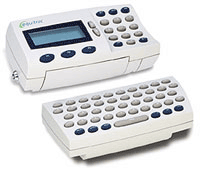 Trying to account for every piece of paper running through your copiers and printers could be a lesson in futility … particularly for colleges dealing with multiple constituencies, each with different printing needs and different ways of paying for the services. Equitrac, Inc., a Plantation, Florida-based company, has been handling those document accounting functions for the corporate world, primarily law firms, for more than a quarter century. In the past half dozen or so years, the company has moved into the higher education market and is now on its third version of a software product designed specifically for colleges to help them control their copying and printing costs.
Trying to account for every piece of paper running through your copiers and printers could be a lesson in futility … particularly for colleges dealing with multiple constituencies, each with different printing needs and different ways of paying for the services. Equitrac, Inc., a Plantation, Florida-based company, has been handling those document accounting functions for the corporate world, primarily law firms, for more than a quarter century. In the past half dozen or so years, the company has moved into the higher education market and is now on its third version of a software product designed specifically for colleges to help them control their copying and printing costs.
Equitrac’s vice president of technical marketing, Chris Wyszkowski, explained: “Document accounting is all about monitoring and managing the costs associated with document activity, output and input, scanning, faxing, printing. It’s about cost control and cost containment. As in any vertical, such as the education market, document accounting could provide them (universities) with a revenue source.”
Twenty-five years ago, “Equitrac was helping law firms, assisting them to bill their clients for all kinds of documents. Over the past five to eight years, we took what we learned from the legal market and began applying it to other markets,” said Mr. Wyszkowski.
He said Equitrac, in the delivery of accounting systems for legal firms “developed a wide range of relationships with equipment manufacturers (e.g. Ricoh, Xerox). We became recognized as the world-leader at providing document accounting. So, it was actually our manufacturing partners who engaged us to build solutions for the education market so they could sell their modern copiers and enable schools to manage these copies. That’s what created the opportunity and we’ve continued to build on that.”
A specialized system was needed because colleges needed the ability bill the various constituent groups appropriately.
At a law firm or corporation, you have one set of constituencies, the employees. But, said Mr. Wyszkowski, “At a university, you have a few groups of people using it; students, who might be on a quota or payment system; staff, who use the printers and copiers as a part of their job with the costs being allocated to a specific department, and faculty, who might have a set number of free copies and need it for their course work…”
 Unveiled at the National Association of Campus Card Users show in March, Equitrac Express 3, includes several new features, such as allowing students to preview their documents and to send their jobs to any “device group” printer. For example, Mr. Wyszkowski explained, a student sends a print job to the system. He is told how much it will cost him. He agrees with the cost (there are several payment methods, including stored value on a card specifically set up for the print program, or through his campus or credit card), okays the job, which is then placed in a print queue. The student can then go to any printer in the “device group” to retrieve his job.
Unveiled at the National Association of Campus Card Users show in March, Equitrac Express 3, includes several new features, such as allowing students to preview their documents and to send their jobs to any “device group” printer. For example, Mr. Wyszkowski explained, a student sends a print job to the system. He is told how much it will cost him. He agrees with the cost (there are several payment methods, including stored value on a card specifically set up for the print program, or through his campus or credit card), okays the job, which is then placed in a print queue. The student can then go to any printer in the “device group” to retrieve his job.
“Express 3 is really focused on allowing different constituencies – student, faculty and staff – to have access to the same device but with different billing requirements depending on who they are,” said Mr. Wyszkowski.
“Our product will work for virtually any size campus. We have a small campus edition, used by small campuses or a single department with a single server. We also have a suite version that’s scalable to large organizations, with multi-server deployments, encompassing campus scenarios with thousands of printers and tens of thousands of users,” he added. He estimates Equitrac solutions are currently in “hundreds of colleges.”
The new version also offers a “significant set of improvements from an IT standpoint. It supports all the major operating systems, Windows, Novell, Unix, Linux, Macintosh. And no matter the type of infrastructure, you can integrate it into your print environment,” he added.
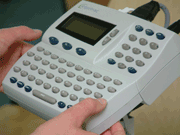 By enabling campus-wide billing integration, Equitrac’s Express also eliminates the need for separate printers and copiers for students, faculty and staff, allowing schools to more efficiently assign device resources across campus.
By enabling campus-wide billing integration, Equitrac’s Express also eliminates the need for separate printers and copiers for students, faculty and staff, allowing schools to more efficiently assign device resources across campus.
Equitrac will also work “with backend campus card solutions. We have an existing interface with Blackboard and we’re investigating adding interfaces for Diebold and CBORD,” he said.
This business has been growing steadily as document production becomes an increasingly larger output at a business or university. “In some organizations, it’s a fariy high expense item. If you can control it and save 25% off your document processing, that can be quite a significant savings,” said Mr. Wyszkowski.

To read about Equitrac’s solutions for higher education on the web, click here.

At the recent National Association of Campus Card Users conference in Orlando, I spoke with several bankers and a number of campus administrators about credit cards. Though far from a scientific study, the conversations suggest to me that the issue of campus cards and credit may be heating up again. In the late 90’s, during the heyday of the affinity credit card expansion, issuers were racing to ink deals with like-minded groups providing cards to group-members that suggested and ‘supported’ the group’s mission. From sports teams to hobbyists, everything was fair game. And college alumni organizations were among the most sought-after categories.
As the signing bonuses and incentive pay provided to major alumni associations grew well into the tens of millions of dollars, the idea of capturing the students before they became alumni (and before the issuer was required to fork over the major dollars) was borne. For years, credit card solicitation tables at events and in student unions were prevalent. But this was a slow churn process and the playing field was level for all issuers. How could one gain massive advantage?
Enter the campus card program … well-established on campus, respected by students and parents, versed in offering/marketing card-based services to campus populations. The fit seemed natural. In addition, card offices were more entrepreneurial than typical campus departments and, almost without exception, they were searching for funds.
Obstacles abound …
When the credit card issuers came calling, however, they quickly found roadblocks that were not encountered in traditional affinity card relationships. A string of emotional, technical, and financial obstacles emerged.
First, a very strong sentiment against ‘institutionally-endorsed’ credit existed among many in the various campus populations. Outspoken students, outraged parents, and gun-shy administrators let it be known that this would not be a hassle-free initiative.
From a technical standpoint, it became clear early on that the issuance of the cards would pose a problem. Most campus card programs required instant issuance so that the student could use the card for essential services (e.g. dorm access, dining, library services) immediately. The major credit brands required that their cards be issued in secure facilities using strictly controlled processes to reduce fraud and counterfeiting. Because students could not wait a week–or even a day—for their ID card, the idea that the actual student ID would double as the credit card took another blow.
Issuers also ran up against financial hurdles. Many administrators stressed that if a credit product was to be issued as a part of the card program, it would have to be available to all students. Credit card issuers, however, use guidelines to restrict the provision of credit to those deemed good candidates for repayment. Students with negative credit ratings did not fit the model, and in many cases, students with no credit rating (arguably the majority of incoming students) would be declined as well.
So what has changed?
The obstacles described above effectively killed the issuance of credit via the campus card in all but a few limited trial programs. Does the current re-emergence of the discussion suggest that times have changed or is it simply talk?
To a certain degree, each of the obstacles still remains though their severities have diminished. Credit is still a ‘dirty word’ to some on campus, though the culture—both on campus and in the country as a whole—seems more tolerant. The staggering statistics regarding student credit card usage show that credit is a fact of life for college students. Perhaps institution-endorsed credit, coupled with mandatory responsible credit education, would be preferable to the current chaotic environment.
The technical issue of instant issuance has been overcome to a large extent as demonstrated by the host of campuses that have successfully deployed Visa and MasterCard branded debit products. Innovative issuers have created mobile secure issuing facilities while others have built processes that issue temporary cards to enable campus functionality while the branded card is processed and mailed. These same solutions could readily apply to credit issuances as well.
Finally, several of the issuers I have spoken with suggest that they understand that 100% acceptance may be required. It has been suggested that a limited-line (e.g. $200) could likely be offered to all individuals with higher lines for those that qualify.
The future campus cards and credit
While it does seem that some of the issues that derailed it in the past may have eased, this is still a thorny issue. What will happen in the coming years? Only time will tell. Certainly a major driver for the inclusion of a credit product from the campus perspective is the potential funding source from up-front and/or ongoing revenue sharing. Card programs continue to seek new sources as pressure to be self-supporting continues to mount. Stay tuned.
Article written by CR80News Editor Chris Corum

